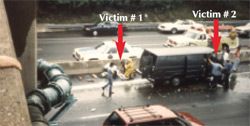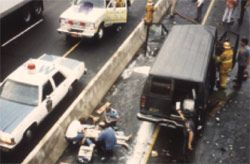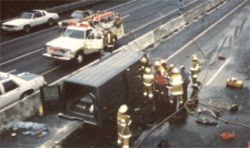By A.J. HEIGHTMAN, EDITOR-IN-CHIEF, JEMS
|
|
|
|
|
|
The 21st of June was a hot day — the first day of summer and my birthday. My fire department was dispatched to the westbound lanes of an interstate highway where a tractortrailer carrying pipes that were loaded too high on the trailer impacted a highway overpass, causing the top row to be sheared off. Immediately after landing on the roadway, the pipes were hit headon by a painter’s van traveling in the passenger lane.
I was the first EMS command officer to arrive on scene. I gave a brief scene assessment to responding units, reporting that we had two victims, one heavily trapped, a painter’s van involved, paint leaking on the highway, and no smoke or fire visible from the highway level.
A local police officer photographed the scene from the top of the overpass and later reported seeing a green mist in the air over the van. However, this was not reported to me or other responding units.
I was confronted with a male in his 30s who had been ejected from the passenger side on impact and was lying on the road at the rear of the van. He was conscious and complained of neck, back and leg pain (see Photo 1).
His passenger, a 22-year-old male, was pinned in the right front seat. The van’s front end was pushed into the passenger compartment, and scalding hot water from the vehicle’s radiator was leaking on the passenger’s genital region.
The trapped patient’s other complaints and visible injuries included a fracture/dislocation of his right femur/hip, an open fracture of his left patella, facial abrasions, neck and back pain, and dyspnea.
I asked state troopers and bystanders to stay with the driver and keep his neck and spine in a neutral position and gave priority attention to the trapped patient. I radioed an incoming mini-pumper to provide me with water to dilute and cool the hot water leaking on the patient and requested that a medical helicopter be dispatched.
The engine crew charged a small-diameter line and began flushing the patient’s lower body regions (see Photo 2). With the patient’s C-spine immobilized and high-flow oxygen started, extrication began. During the course of the rescue, the patient’s dyspnea ended and he appeared more coherent than when I first arrived. However, the personnel extricating the patient, myself included, began to show signs of extreme fatigue.
I assumed that the high heat and humidity of the afternoon, the complicated rescue, patient packaging and our heavy turnout gear were causing our lethargy. But I was wrong. The strange green cloud that the police officer on the overpass observed was actually methylene chloride vapors being emitted from the paint solvents leaking along with the paint, causing us to unknowingly be exposed to carbon monoxide (see Photo 3).
An alert fire officer realized that the spilled contents were causing our symptoms, particularly because the trapped patient (who was being flushed with high-flow oxygen) was no longer dyspneic, while his rescuers were exhibiting unusual signs of lethargy and dyspnea. He ordered exhaust fans placed around the van to ventilate the area.
After the extrication was completed and the patient was turned over to the MedEvac crew, rescuers began to collapse, and eight of us ended up as priority 1 patients. During triage and treatment, we presented with symptoms that included tachycardia, hypotension, lethargy and dyspnea. My pulse was 130, my respiratory rate was 28 and my BP was 80/60. With high-concentration O2 flowing and bilateral IVs running wide open, I and the other rescuers were transported to area hospitals and treated for carbon monoxide exposure.
We were all released after extensive testing and hours of fluid and oxygen therapy. But the trauma of our exposure didn’t end that day. As a result of our prolonged exposure, several of us sustained lung damage that now results in chronic bronchitis and emphysema.
We learned many lessons at this incident, including the need for a designated safety officer at all scenes, the need for better police-to-EMS communications, to use SCBA any time foreign substances are present, the need for CO monitoring devices — and the invisible and damaging effects of carbon monoxide exposure.




